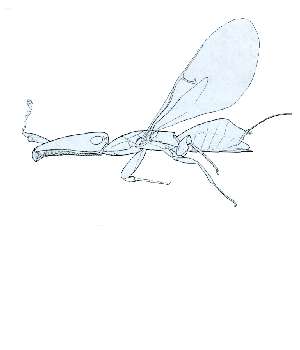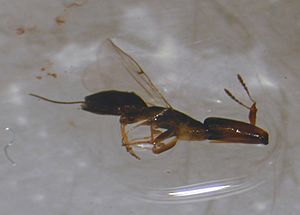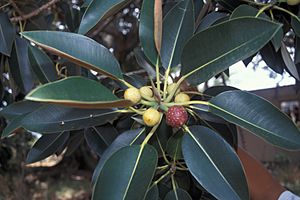Pleistodontes froggatti facts for kids
Quick facts for kids Pleistodontes froggatti |
|
|---|---|
 |
|
| Pleistodontes froggatti | |
| Scientific classification | |
| Synonyms | |
|
Pleistodontes semirucifeps Girault |
Pleistodontes froggatti is a tiny fig wasp that comes from Australia. It has a very special partnership with the Moreton Bay Fig tree, Ficus macrophylla. This wasp helps to pollinate the fig tree, and in return, the fig tree provides a safe place for the wasp to lay its eggs and for its young to grow. This partnership is so important that neither the wasp nor the fig tree can survive without the other! You can also find these wasps in Hawaii and New Zealand, where they arrived either by accident or were brought there on purpose.
Contents
What Does the Fig Wasp Look Like?

Pleistodontes froggatti is a small wasp. Female wasps are about 3.0–3.4 mm (0.12–0.13 in) long. They have bodies that are black, brown, and reddish-brown. Male wasps are even smaller, only about 1.5 mm (0.059 in) long. Their bodies are usually yellow and orange.
How Was This Wasp Named?
The name froggatti was given to this wasp to honor an Australian insect expert named Walter Wilson Froggatt. He was the first person to write about the life of this wasp in 1901. However, he mistakenly thought it was a different type of wasp.
Later, in 1906, an Austrian insect expert named Gustav Mayr studied the wasp again. He correctly identified it as a new species. He then named it Pleistodontes froggatti to recognize Froggatt's earlier work.
The Fig Wasp's Life Cycle
Fig trees and fig wasps have a unique partnership called an obligate mutualism. This means they absolutely need each other to survive. Fig trees can only be pollinated by fig wasps. In return, fig wasps can only lay their eggs and raise their young inside the flowers of fig trees.
The Pleistodontes froggatti wasp can only reproduce inside the special fruit-like structures, called syconia or figs, of its host tree, the Moreton Bay Fig. The female wasp enters the fig, pollinates the tiny flowers inside, and lays her eggs. The young wasps then grow and develop inside the fig.
Where Does the Fig Wasp Live?
The Moreton Bay Fig tree, which is the host for Pleistodontes froggatti, naturally grows in southeast Queensland, eastern New South Wales, and Lord Howe Island in Australia. These trees have also been planted in many other parts of the world.
The Pleistodontes froggatti wasp can be found throughout most of the areas where its host tree grows in Australia. It also lives in New Zealand and Hawaii.
How It Spread to Hawaii
The Moreton Bay Fig tree was brought to Hawaii in the 1920s. The P. froggatti wasp was then deliberately introduced to Hawaii in 1921. Since then, it has been found on several Hawaiian islands, including Hawaiʻi, Lānaʻi, Kauaʻi, Oʻahu, and Molokaʻi. It is also likely present on Maui. These wasps have even been found on the Midway Atoll.
How It Spread to New Zealand
The Pleistodontes froggatti wasp was first seen in New Zealand in 1993. This was a journey of about 3,000 km (1,900 mi) from its closest home in Australia! Adult female wasps usually live for only 2 to 3 days. However, there are about 21 days each year when air currents could carry them across this distance in 1 to 3 days. It's also possible that a female wasp could have traveled by hitching a ride on an airplane.
After arriving in New Zealand, the P. froggatti wasps quickly spread. They used the many Moreton Bay Fig trees that had been planted there. The arrival of the wasp meant that the fig trees started producing many fruits with tiny seeds. These seeds are perfect for birds to eat and help spread the fig trees even further.


